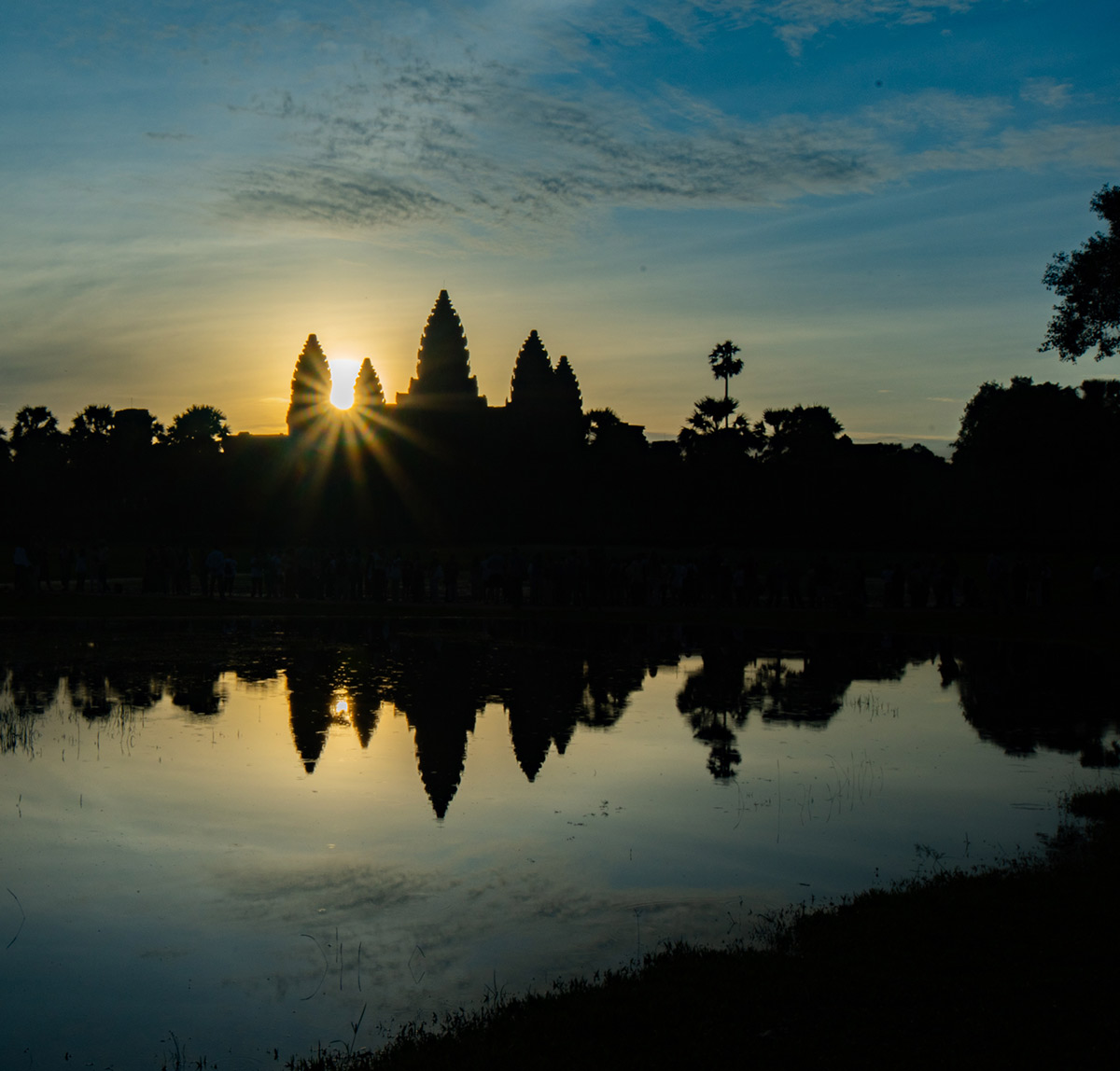Angkor Wat (អង្គរវត្ត) is considered to be the largest ancient city in the world and is by far the most famous sight in Cambodia. Every year, tourists from all over the world travel to this place to visit the monumental ruins dating back to the 12th century.
Things to know about the Angkor Wat temple complex
As a monument steeped in history, Angkor Wat is the most important landmark in Cambodia. So it is no coincidence that the temple with its striking five towers, reminiscent of lotus blossoms, is depicted in many places. For example, on the notes of the Cambodian currency Riel and the official national flag. And: As a cultural asset of Cambodia, Angkor Wat has been a UNESCO World Heritage Site since 1992.
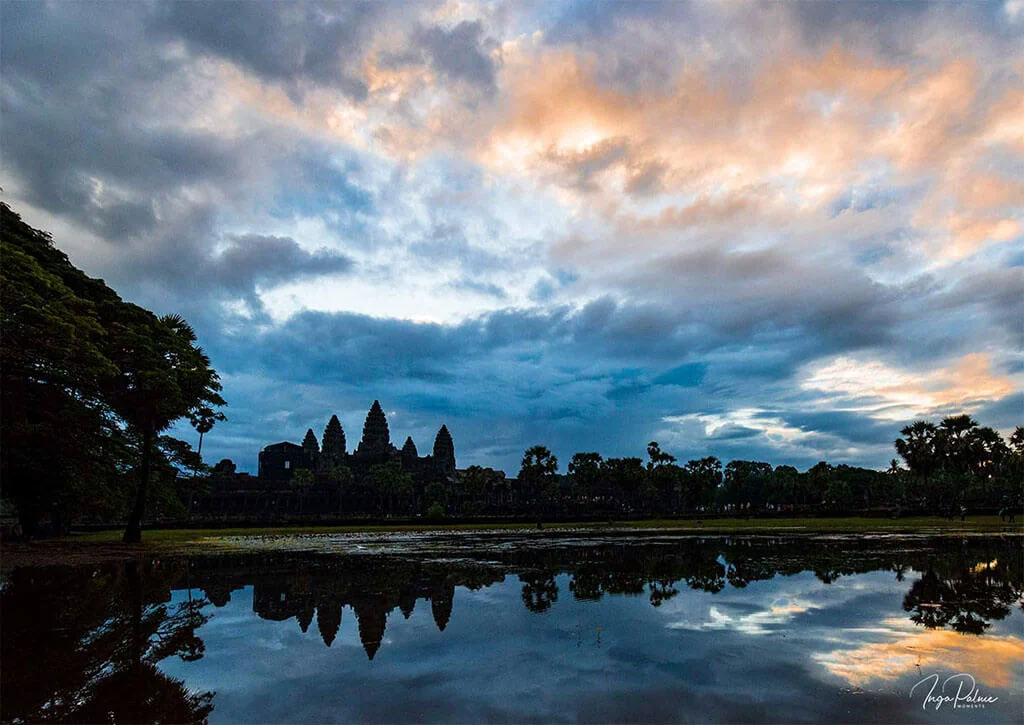
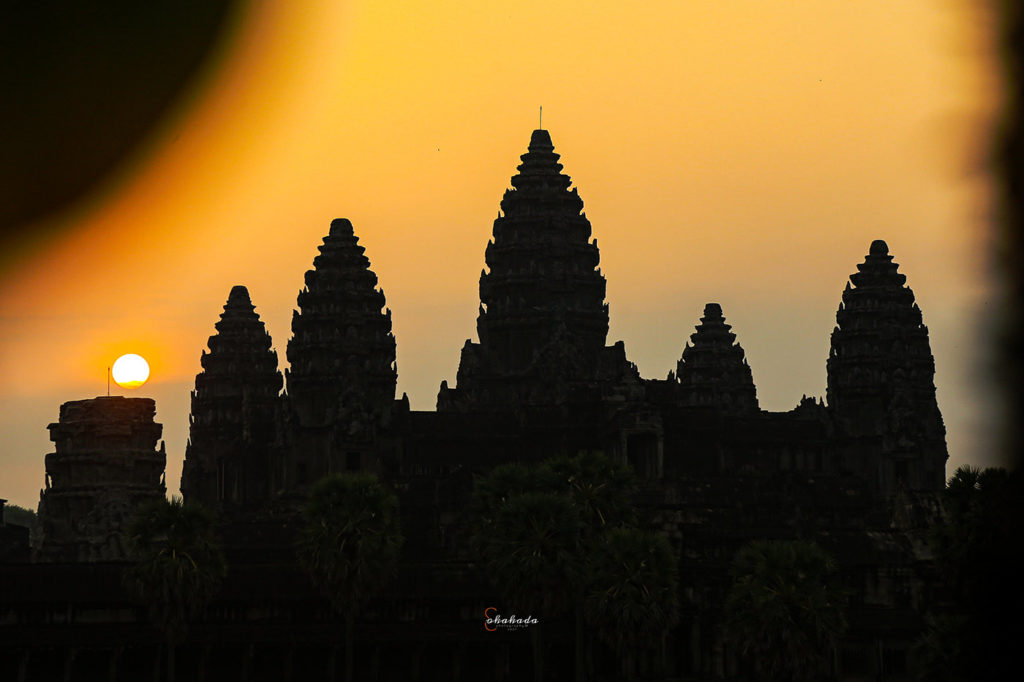
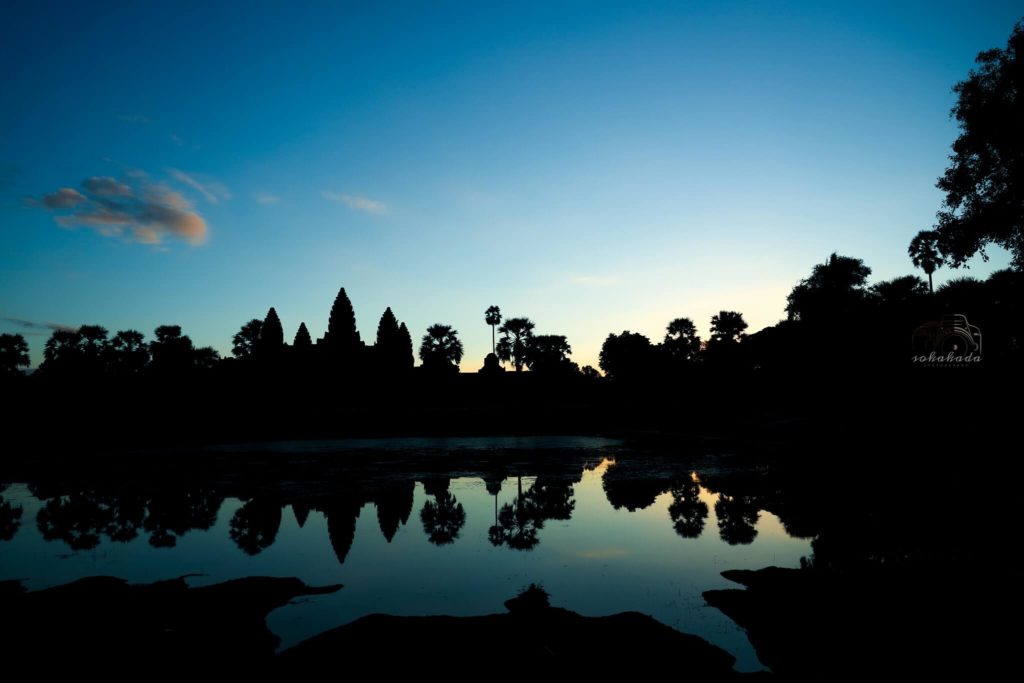
Because of its fame, it is often assumed that Angkor Wat is the eponym for all the temples in the archaeological Angkor Park. It is true that the Angkor Empire had its heyday in the 12th century. It is also true that there are numerous Angkor temples that people can visit today. For example, Ta Prohm Temple, made famous worldwide by Tomb Raider, with its overgrown masonry. Or the Bayon in the heart of Angkor Thom, which delights with its huge faces carved in stone. Angkor Wat, on the other hand, is one of the many temples of Angkor and at the same time the most important of all.
The name “Angkor Wat”
Angkor means “city” and Wat means “temple” and literally translated simply “city temple”. There are sources that say that the term “Vat” is of Thai origin and means something like “monastery”.
In any case, the original Brag Bishnulok or Vishnuloka was renamed today’s Angkor Wat. Accordingly, Angkor Wat loosely translated means “royal city that (has become) a Buddhist monastery”.
Size and age of Angkor Wat
The size of Angkor Wat is enormous, the architecture unique in the world. The temple mountain, consisting of 3 terraces, symbolises the sacred Mount Meru, the centre of the universe. Together with the surrounding moat, which represents the primeval ocean, the site covers the enormous area of 200 hectares. That is 2 square kilometres and roughly equivalent to 185 football fields.
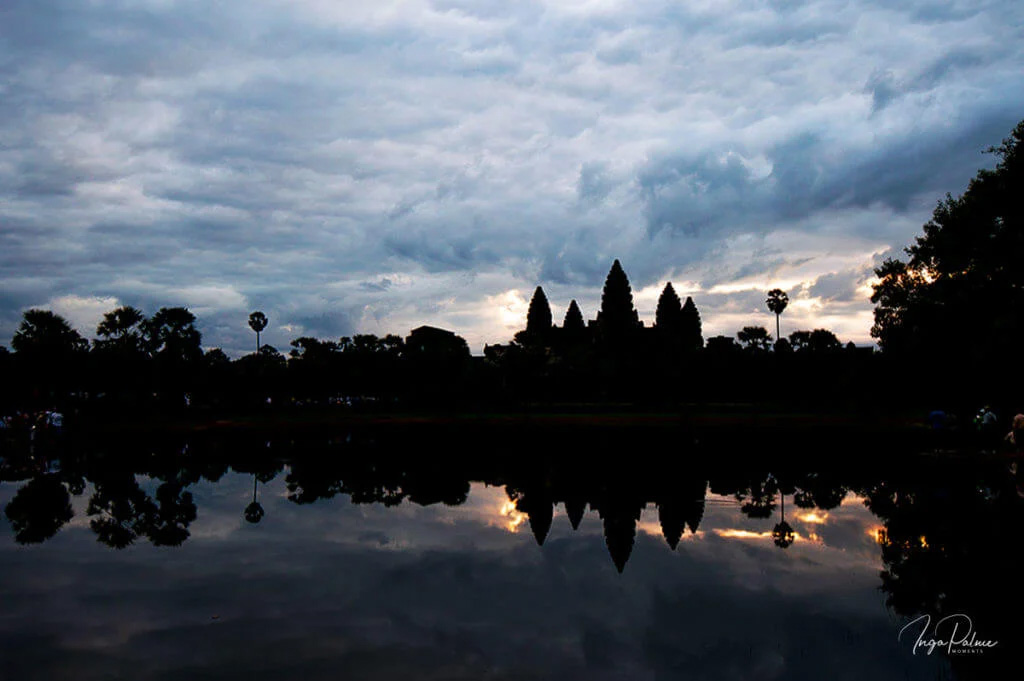
Although King Suryavarman II (1113 and 1150) has built the later Angkor Wat earlier – it was not until King Jayarvarman VII (1181 to after 1206 or 1220) that the Khmer switched to Buddhism and gave it its present name.
The First Terrace
Directly adjoining the Gopuram to the east are two galleries, the Halles des Echos and the 1,000 Buddhas (Preah Poan). Several Buddha statues have been collected here over the years. Most of them were left by pilgrims. Unfortunately, many statues fell victim to the misdeeds of the Khmer Rouge reign of terror. Those that remain are now stored with many other ancient Angkor treasures at Conservation D’Angkor. To the delight of the gods and the blessed, the walls of Angkor Wat are decorated with dancing Apsaras. With their bare breasts and seductive smiles, they radiate an eroticising sensuality.
The Second Terrace – Meditation Place of the Priests
Towards the east, the two galleries open into a gopuram leading to the second terrace. This was dedicated to the priests for meditation and closed off from the outside world by a windowless wall. Completely unadorned, the aim here was to achieve perfect and pure contemplation. Contemplation – the basis for true wisdom.
The Third Terrace – the Centre of Power
At the latest when you want to visit the third terrace with its 5 towers (also called Quinkunx), you need suitable clothing. This means that your shoulders and knees must be covered, otherwise you will not be allowed to enter. The place is still sacred today and in former times only priests and kings were allowed to enter this top level. For here, in the central tower, dwelt Vishnu and the ruler was one with the gods. From all sides, the view goes far over Angkor.
TIP
Visit the Third Terrace of Angkor Wat in the afternoon, then it is comparatively quiet and you don’t have to queue so long.
For comparison, the waiting crowd at the entrance to the top level in the morning (picture 1 + 2) and in the afternoon (picture 3 + 4). The photos are all from the same day.
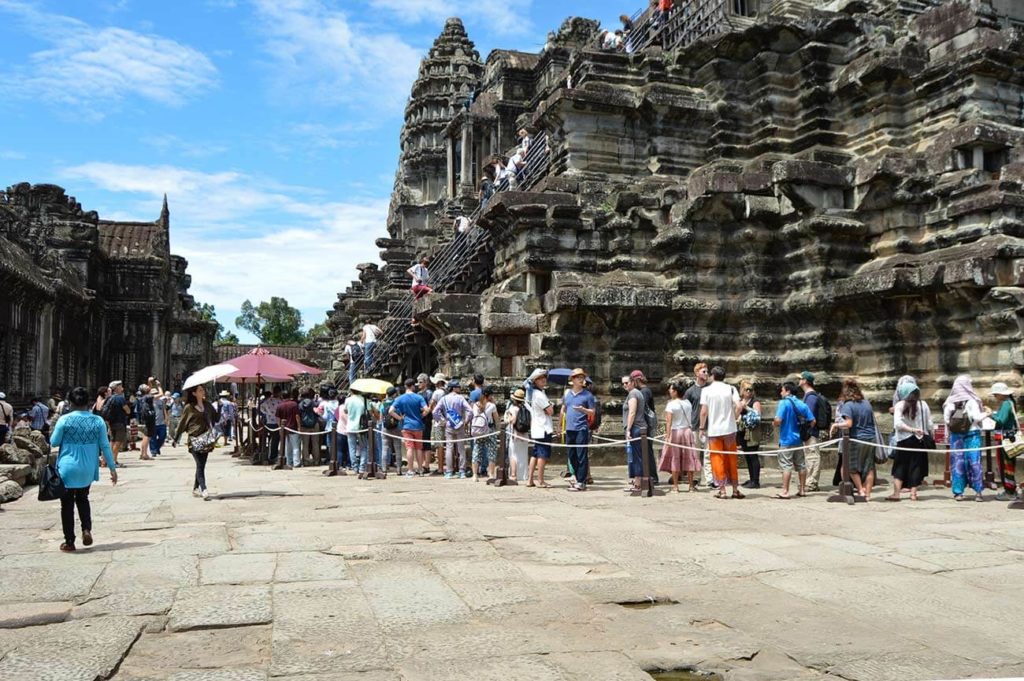
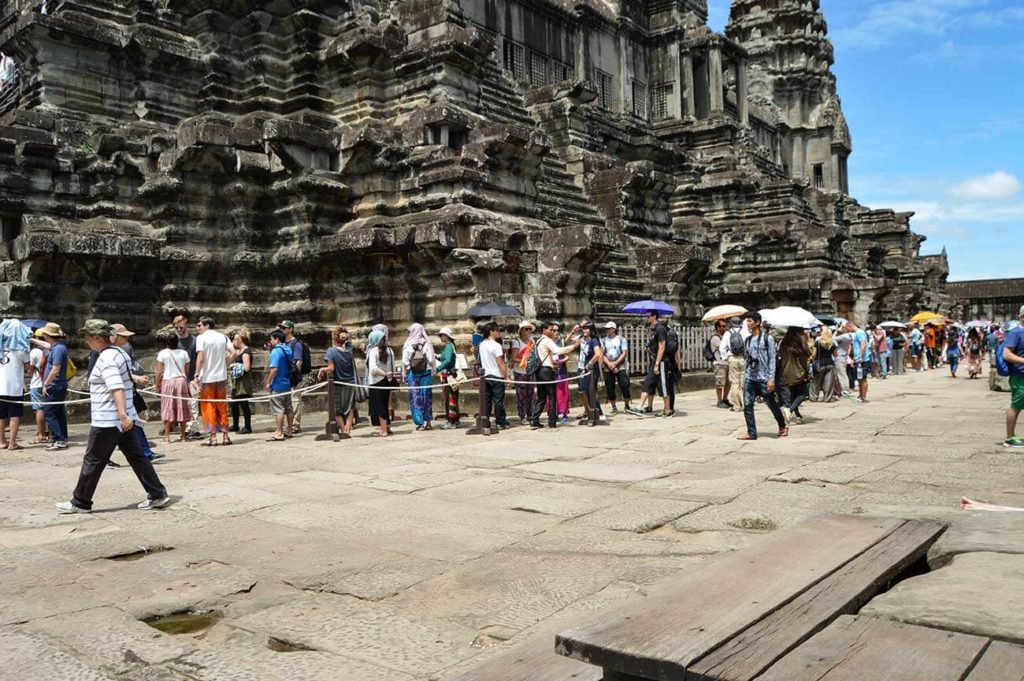
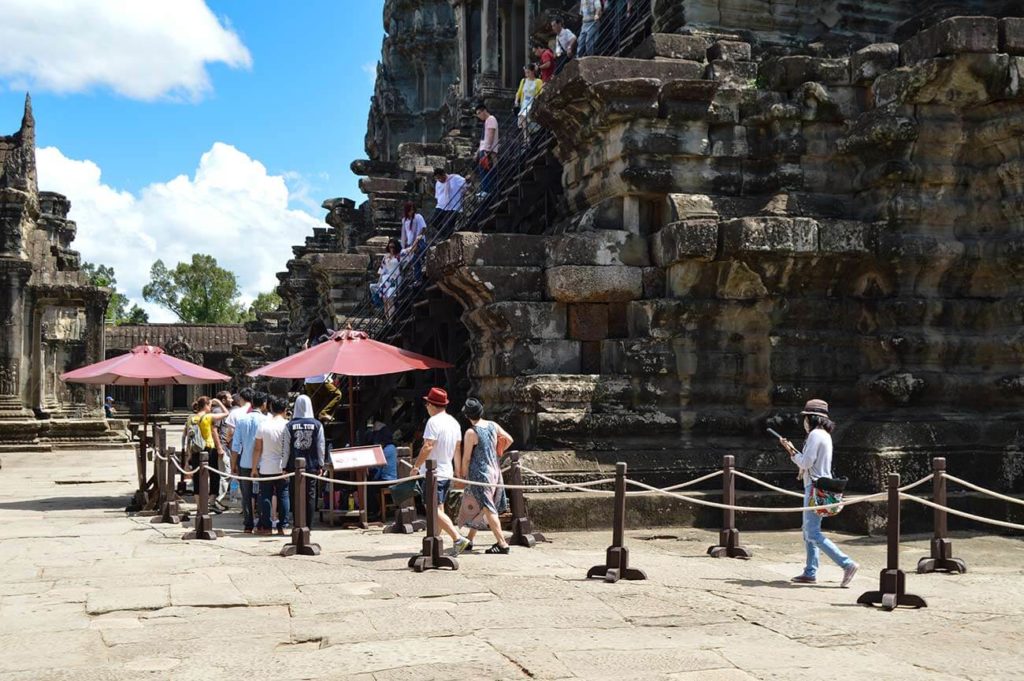
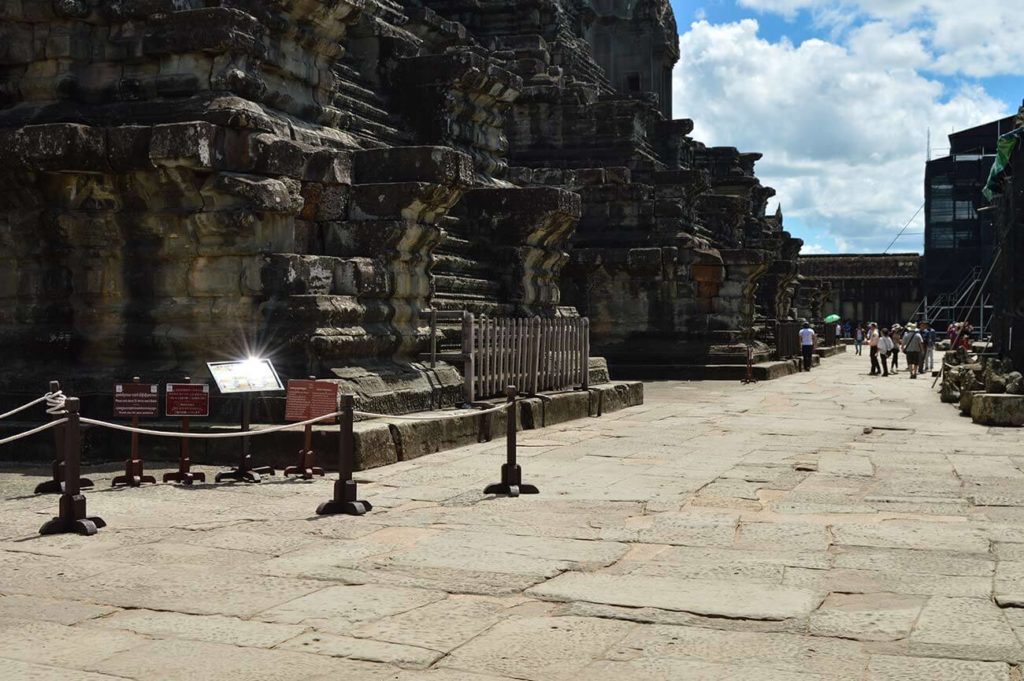
Up to 100 visitors at the same time
Good to know: If it’s very crowded, you won’t have much time to stay on the top level. So that the others down in the queue don’t have to brood endlessly in the sun, you will be asked in a friendly but firm manner to leave the terrace and descend the steep steps again. Depending on the number of people, you may be given a numbered badge, which you hand back after the descent. Only up to 100 people are allowed on this level at any one time.
Once you have reached the top, you can enjoy the view, look down on the common people and feel a bit like a legendary king or queen :-)
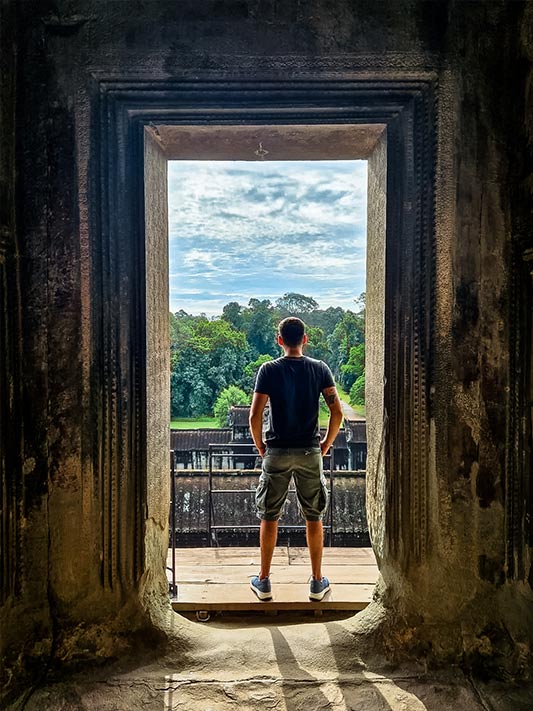
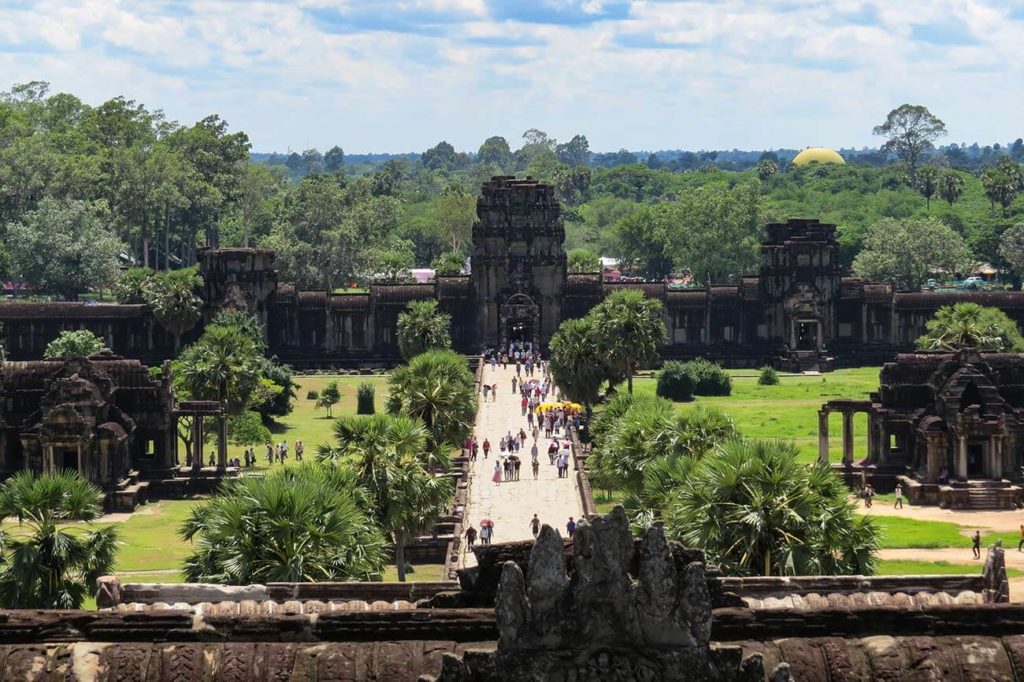
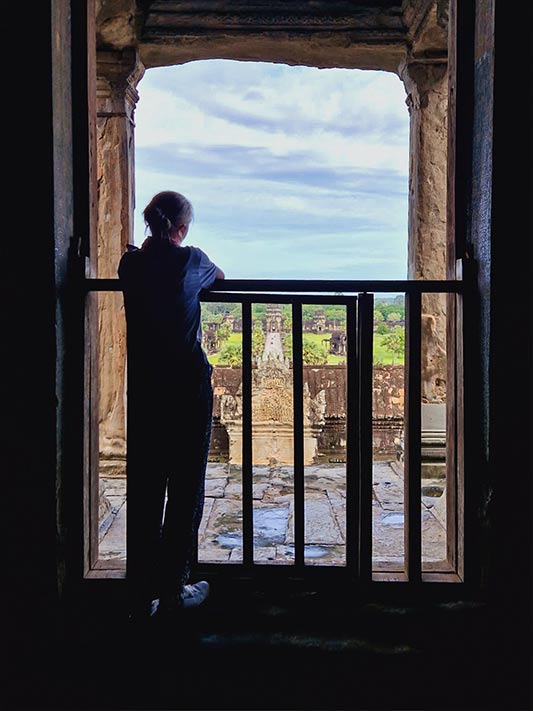
In the photo you can see the long promenade along which you walked to the main temple. In the background is the large entrance gate (the gopuram) and behind it the moat. The photo shows the view to the west to the outermost gopuram and the moat behind it. In the middle are the two cross-shaped libraries. At the far right, a small tip of the yellow balloon can be seen. What hardly anyone knows: from the balloon you have a fantastic view of Angkor Wat and the surrounding countryside!
Everything for your perfect visit to Angkor Wat
Entrance ticket and prices for Angkor Wat
To visit Angkor Wat, you need an entrance ticket. You can get the ticket at the Angkor Ticket Centre, which is located directly at the entrance to the Angkor temple complex. Don’t worry, all Cambodians know the way there. There are three price categories:
- 37 USD: This ticket entitles you to visit the temple complexes of Angkor for one day.
- 62 USD: With this ticket you can choose 3 days in a period of 7 days.
- 72 USD: This ticket gives you 28 days and allows you to visit the temples on up to 7 days.
- Angkor-Pass: Actual Prices – Full Details + Online Option
Note: Due to Covid, the government has adjusted the validity of the tickets. All current information about the Angkor Ticket here at Visit Angkor on the page “Angkor-Pass: Actual Prices – Full Details + Online Option”.
Many tourists buy their ticket on the same day they want to see Angkor Wat. But then it is quite crowded. Especially at the counters where tickets are sold for one day, long queues form. To avoid this, you can buy your ticket for the following day as early as 5 pm the day before. And: You can already visit Angkor Wat on the same evening with this ticket.
Alternatively, you can also order your ticket online.
Opening hours of Angkor Wat
In principle, Angkor Wat is open all year round. Only on Buddhist holidays is the top terrace with the five towers closed.
| Opening hours | from | to |
| Angkor Wat 1st + 2nd terrace | 5 am | 5.30 pm |
| Angkor Wat Sanctuary (3rd terrace) | 6.40 am | 5 pm |
Whether and how long you want to visit Angkor Wat and the other temples depends entirely on your interests. Sometimes a morning is enough for Angkor Wat. But it is well worth visiting other temples in the Angkor Archaeological Park. You can find out which ones below in the section “Other temples in Angkor Park” on this page.
Getting from Siem Reap to Angkor Wat
Most visitors book accommodation in Siem Reap, a small town about 5.5 km south of Angkor Wat. It takes about 20 minutes to drive from the small town about 5.5 km south to the temples of Angkor. You can choose between tuk tuk (the moped taxi), car or minibus. You can also rent or ride an e-bike, moped or bicycle.
The hotels and guesthouses will be happy to give you information. The tuk tuk drivers in particular are happy about the lucrative contract to drive you around Angkor Park. Prices are around 25 USD for a whole day.
After your visit to the temples of Angkor, you can freshen up at your accommodation in Siem Reap and spend the evening in the city. Siem Reap is a pretty and lively small town that has increasingly adapted to the needs of tourists in recent years. Hotels and guesthouses are available in all price ranges from under 10 USD to over 250 USD per night. Highlight: In 2020, Viroth’s Hotel in Siem Reap was voted number 1 worldwide in the Travellers’ Choice Award. An overnight stay there for 2 people starts at USD 75 (as of 25.11.2021).
There are numerous restaurants, Pub Street, pagodas and colourful markets with their diverse offerings. There are also various tours in the surrounding area (including floating villages, elephant sanctuary, bird watching, etc.), museums and cultural events. Among the most popular events are the Cambodian circus Phare and Apsara dances.
By the way: Siem Reap has its own international airport. You need a visa to enter Cambodia. There are currently no direct flights. However, this will change as soon as the new airport, about 50 km away, is completed.
Sunrise and sunset: The highlight of Angkor Wat
At sunrise, Angkor Wat provides the perfect backdrop for a spectacular photo. Around 6 am, the sun rises in Cambodia. The most popular spot is the water basin with its water lilies on the left side of the promenade leading to the main temple. To get one of the coveted places, it is therefore not only necessary to get up early at four o’clock, but also to get there as quickly as possible. From the moat, it is still a few metres on foot until you reach the three-tiered temple hill of Angkor Wat. There is less hustle and bustle at the right-hand pond. There, too, the silhouette of Angkor Wat shows itself in all its beauty.
A special highlight is the sunrise at the equinox in March and September. During these days, the sun rises directly over the central tower of Angkor Wat. Truly an architectural masterpiece.

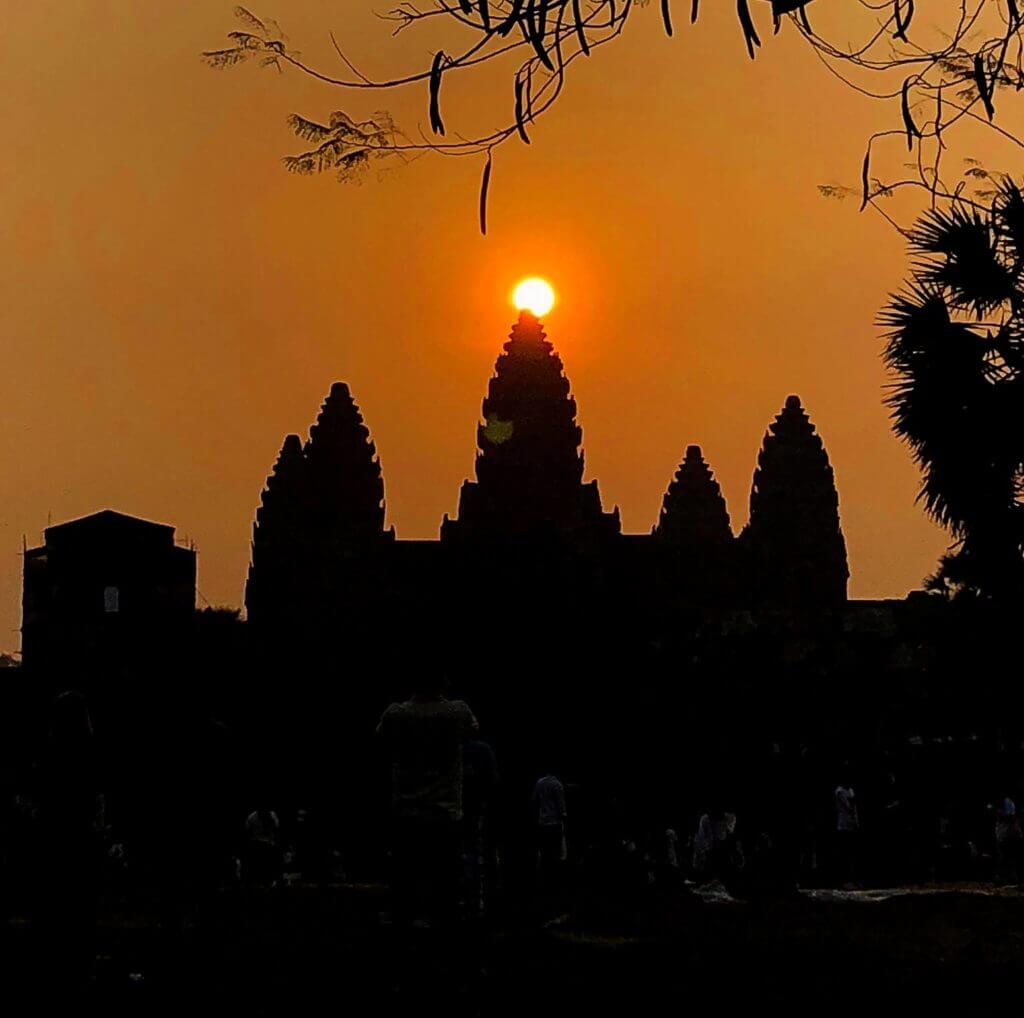
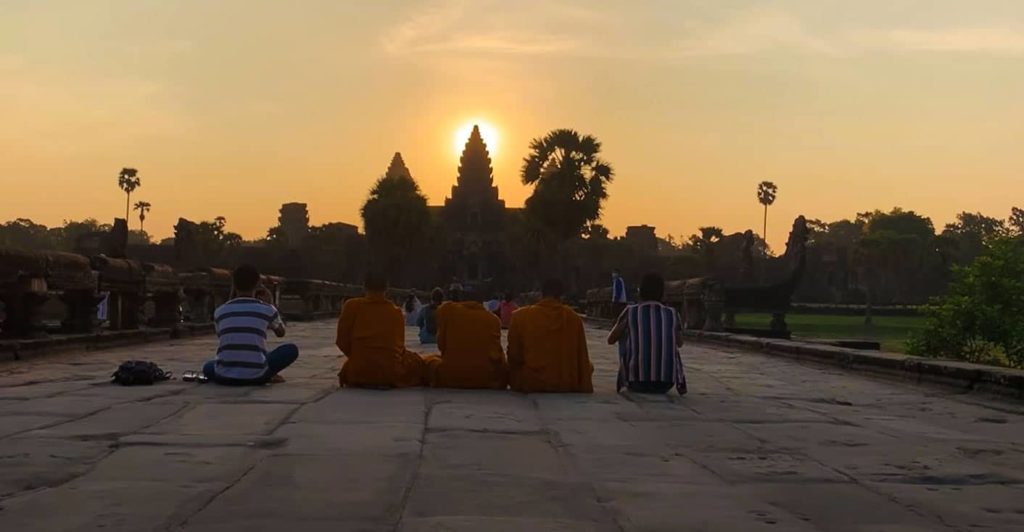
However, as a tourist you will unfortunately hardly have the opportunity to experience this special sunrise with few other guests. This was only possible at times when no one from abroad was allowed to enter Cambodia for corona reasons.
You do not watch the sunset of Angkor Wat directly in the temple complex, but from Phnom Bakheng. This is a small hill located to the west of Angkor Wat. On top of the hill is a temple with a beautiful panoramic view. A small drawback: only up to 200 visitors are allowed on the platform of Phnom Bakheng. It only helps if you climb Phnom Bakheng early in the afternoon.
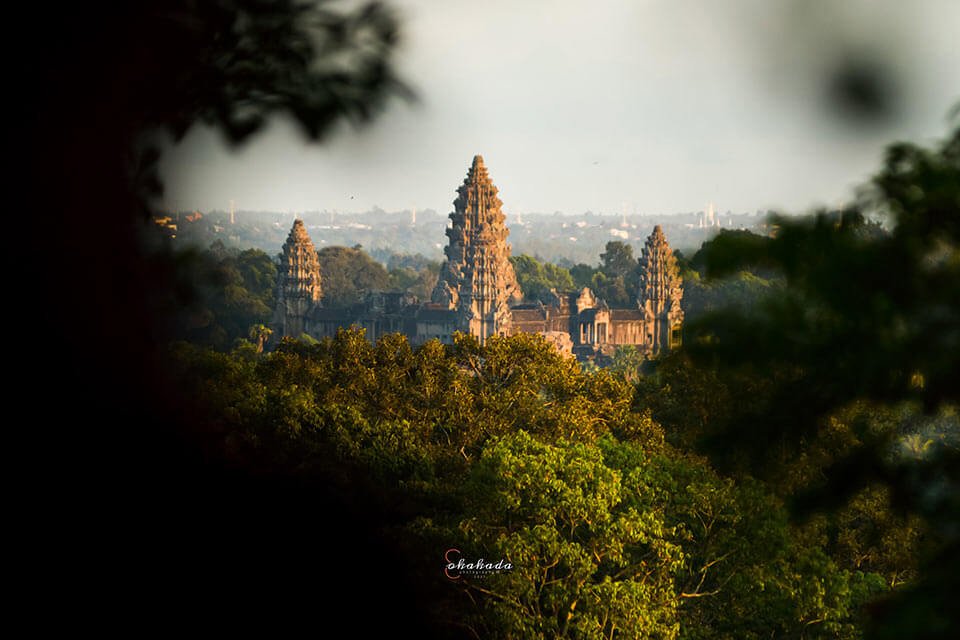
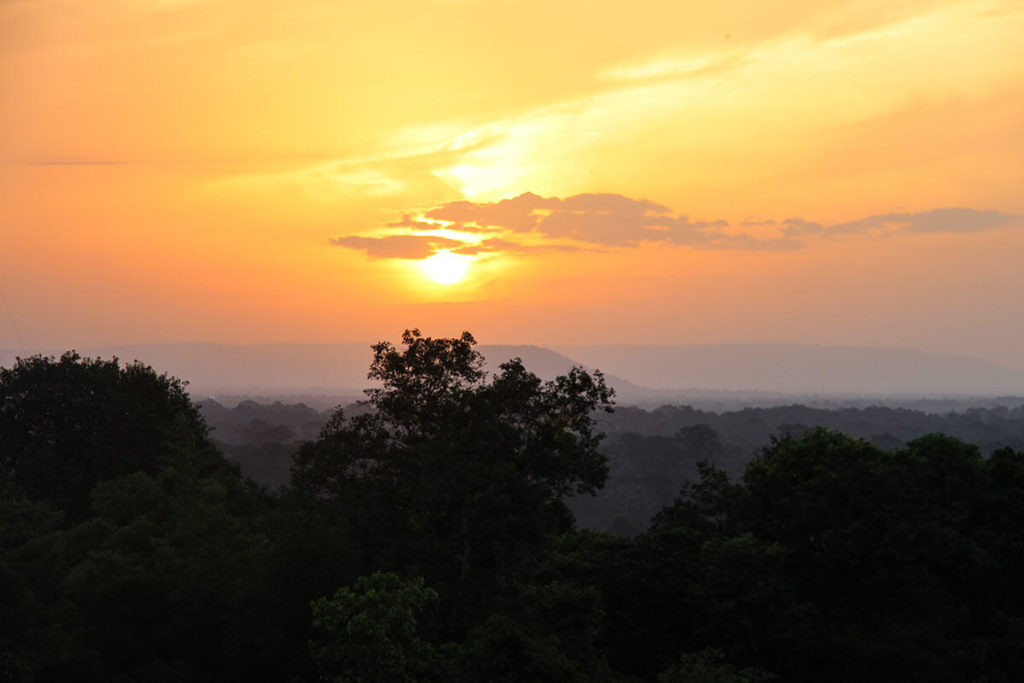
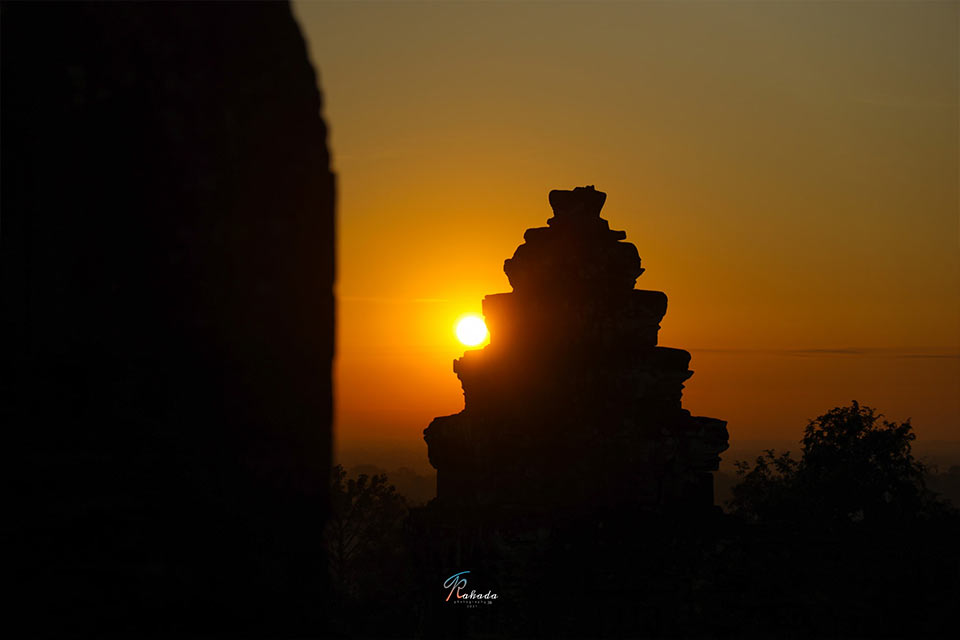
Shall I visit Angkor Wat with a tourguide or not?
Do you only want to look at Angkor Wat and take beautiful photos? Or would you also like to learn something about the background and history of the temple? Our tips for you:
- Explore Angkor Wat on your own
Hire a tuk tuk and visit Angkor Wat and perhaps other temples. Most tuk tuk drivers know their way around, give you tips and drive you to the temples you want to see. You can also rent a bicycle or a scooter. Then you are completely on your own and organise everything yourself. - Angkor tour guide to visit Angkor Wat
With an Angkor tour guide you book an all-round carefree package, so to speak. You don’t have to worry about anything, but leave the planning and implementation of your Angkor Wat tour to your tour guide. The official tour guides are all certified. There are even Angkor tour guides who speak German. If you want to join a group, you will surely find one at GetYourGuide*. - Angkor tour with a photographer
Compared to a tour guide with his tips for successful photos of Angkor Wat, a photographer will help you with camera settings and composition. For special photos of Angkor Wat, a tour of the temple complex with a photographer is just the thing. The two photographers Laurent Dambies and Darren Willich are our favourites. - How about a helicopter ride or jeep tour?
Yes, you read correctly. You can even fly over Angkor Wat in a helicopter and capture the scenery from the air. Or you can be driven around in a real jeep. Information and booking e.g. at our friends from Cambodia Travel Partner. - In style with an old car through Angkor Park
If you want to go back to the golden 20s, you can stroll through Angkor Park in style with a masthead (no, this car market does not exist, but that’s its name). The programme includes a tour guide, delicious red wine, refreshments, lunch and lots of amazed people. We did it and are mega thrilled. More information at Triple K Angkor.
Readers’ tips for visiting Angkor Wat
Here are our reader tips:
- Divide your visit to Angkor Wat into half days. Visit the temples in the morning and the pool in the hotel in the afternoon, otherwise it can be very exhausting in the heat.
- Don’t skimp on transport. The driver waits on the other side of a complex (ask for a mobile phone number).
- There are many temples within a radius of 20-30km. Some of them are beautiful and not overcrowded. Have fun!
Map of Angkor Wat
This is our map – here you can see not only Angkor Wat, but also the other temples you can visit in the Angkor Archaeological Park. You can easily download and print the map.
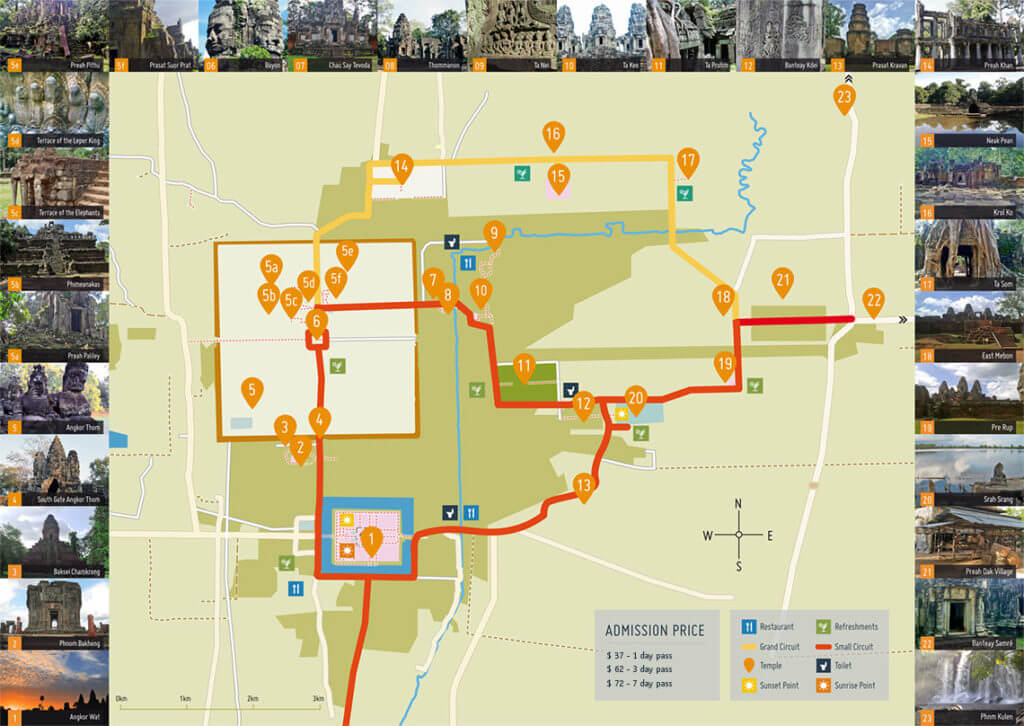
Angkor Wat in the rainy & dry season
From November to April is the dry season in Cambodia and from May to October the rainy season. Basically, both seasons have their own charms. During the rainy season, Angkor shines in lush green. There are also fewer tourists. In the first months of the dry season, it is not so hot and you don’t run the risk of being caught in a rainstorm. However, the number of tourists increases.
Recommendation: Do not necessarily travel to Cambodia at the end of the seasons and visit Angkor Wat. This is because from April onwards, towards the end of the dry season, it becomes increasingly hot. During this time, electricity may be cut off in Cambodia because the rivers have too little water and the supply is insufficient. From the end of September, the rains become more frequent, leading to frequent flooding (also in Siem Reap).
The best times to travel during the dry season are from November to February and during the wet season from June to mid-September.
Photo opportunities of Angkor Wat: reliefs, apsaras, views, monks, statues and more
The most popular photo motif is the silhouette of Angkor Wat at sunrise. Shortly afterwards, many visitors leave the site. Mostly to head straight for the next temple. The Bayon, for example. Others take a break in one of the surrounding restaurants for a first breakfast. Overall, it is quieter and the crowds of visitors disperse. Now you have time to look at Angkor Wat in peace and look for more photo motifs.
Bas-reliefs
On the way to the inner area of Angkor Wat, the outer walls are impressive. Over a length of more than 800 metres, artistic bas-reliefs depicting war scenes, fierce demons and ancient legends adorn the walls. They encompass the inner temple area. Only the rulers stayed there to display their power and connection with the divine. The people were only allowed to approach the interior of Angkor Wat up to these walls. Eight reliefs with their ancient stories – so to speak the “daily newspaper” for the people at that time. There are 2 reliefs per cardinal direction. The interesting thing is that the bas-reliefs start at the southern part of the west gallery and are “read” counter-clockwise.
Apsara & Devata
You will encounter Apsara figures everywhere on the walls. There are said to be around 1850 of these temple goddesses in Angkor Wat alone. The special thing about them: Each of them has its own magic and looks different.
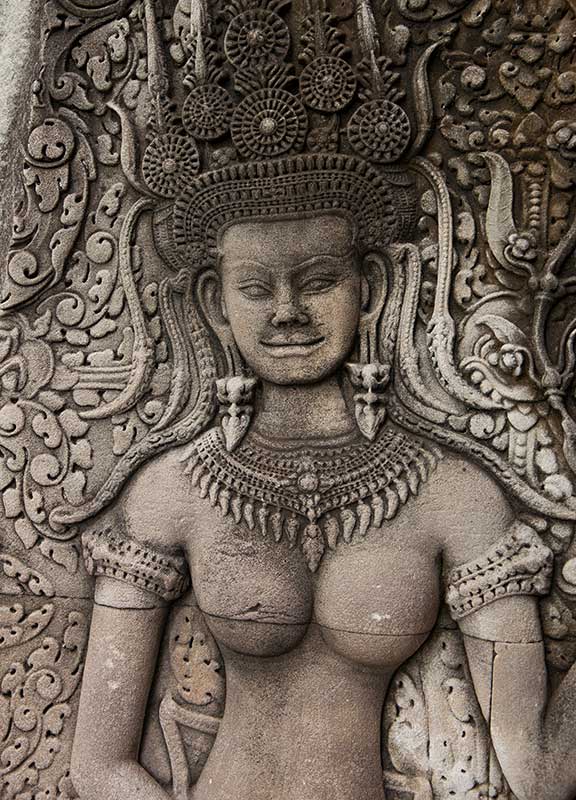
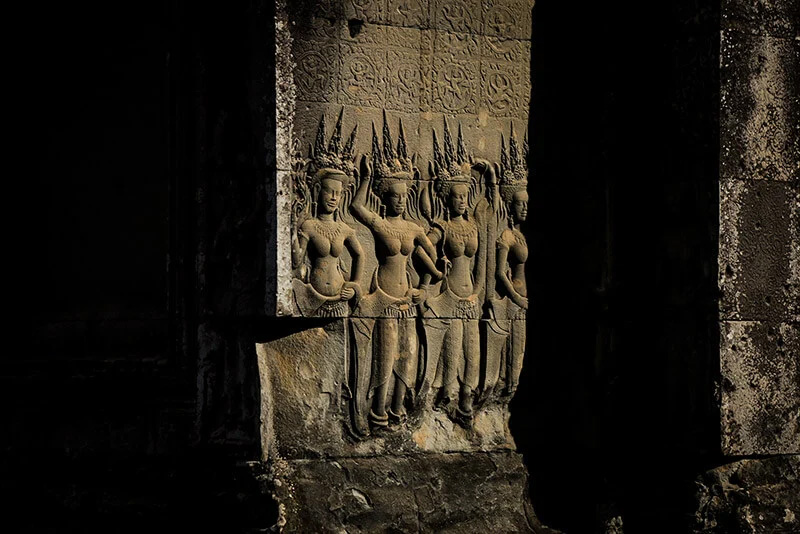
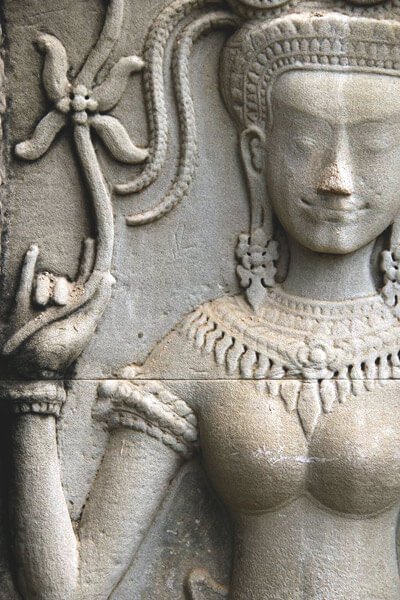
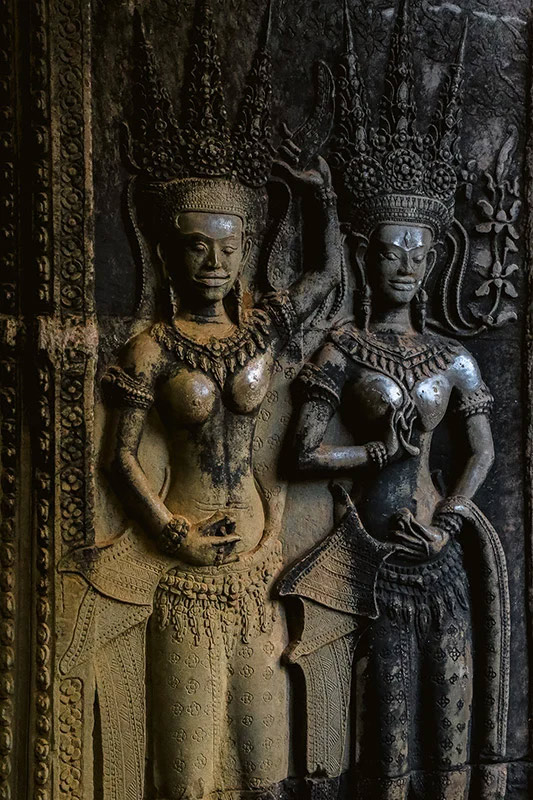
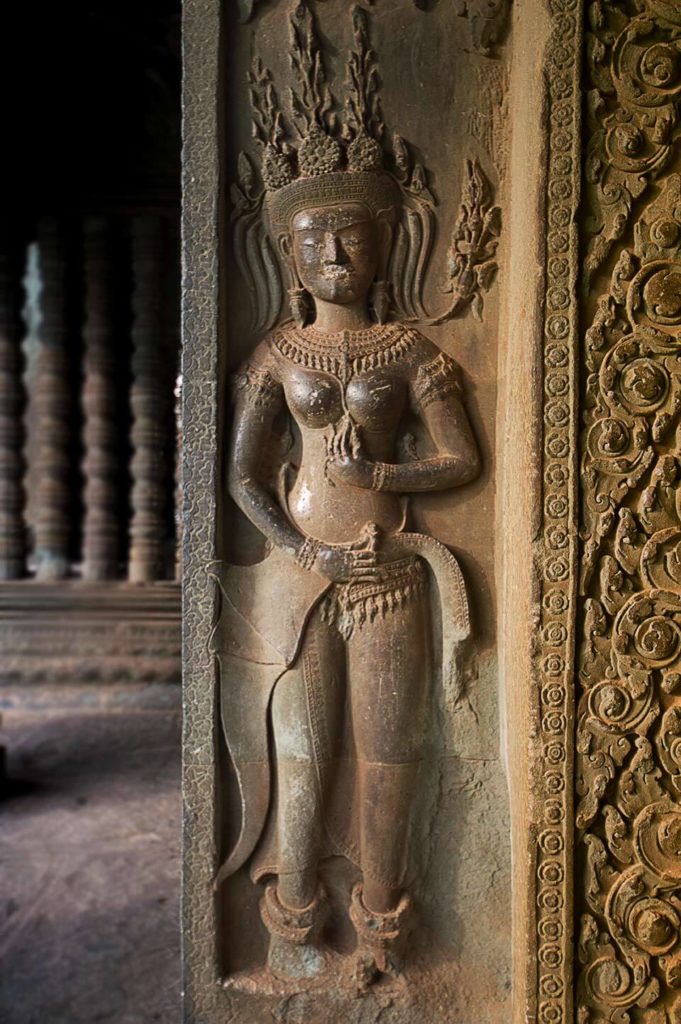
Monks
With a little luck, monks will “run” into your picture. Their orange robes form a nice contrast to the gray walls of Angkor Wat. You can also ask them to take a photo together with you. Good to know: Women are not allowed to touch monks.
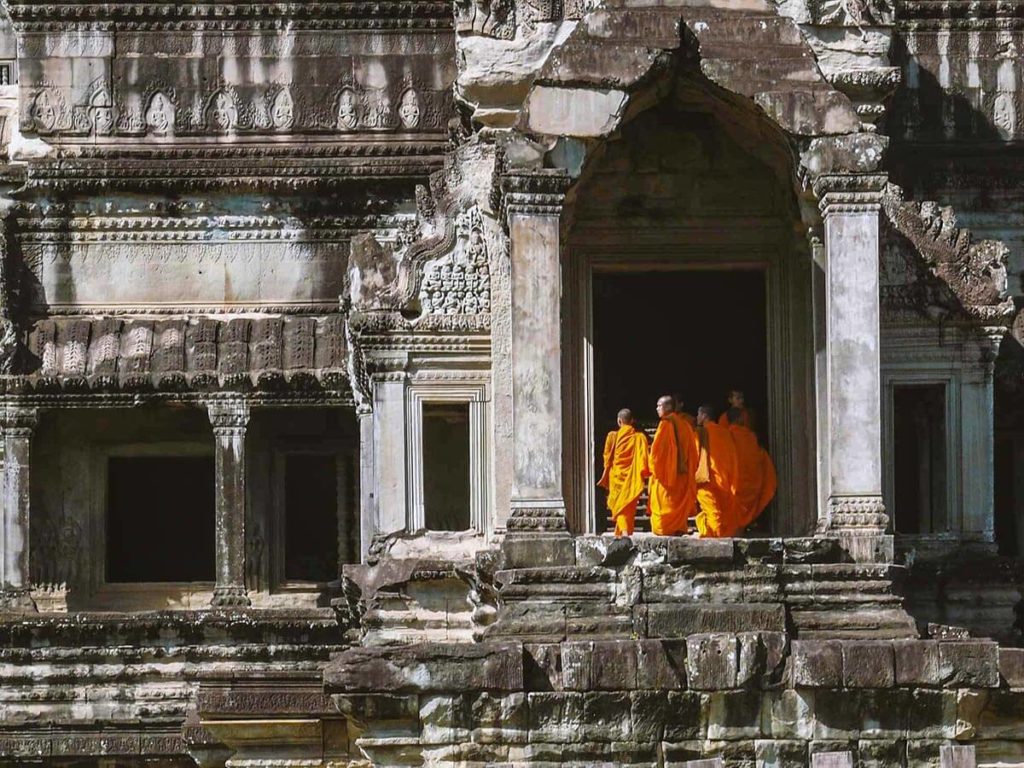
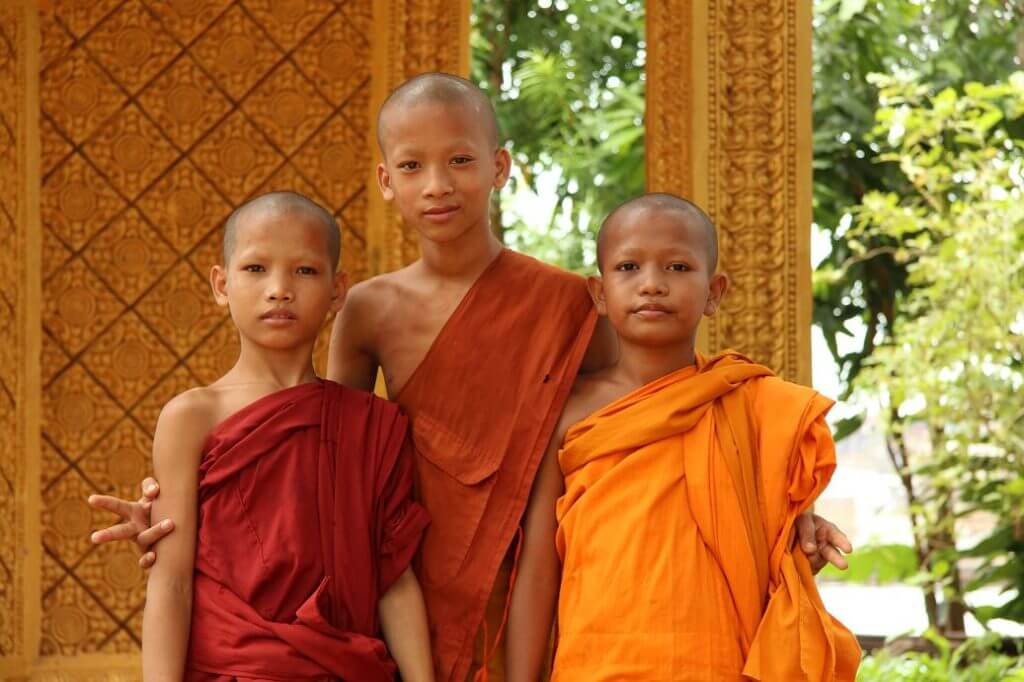
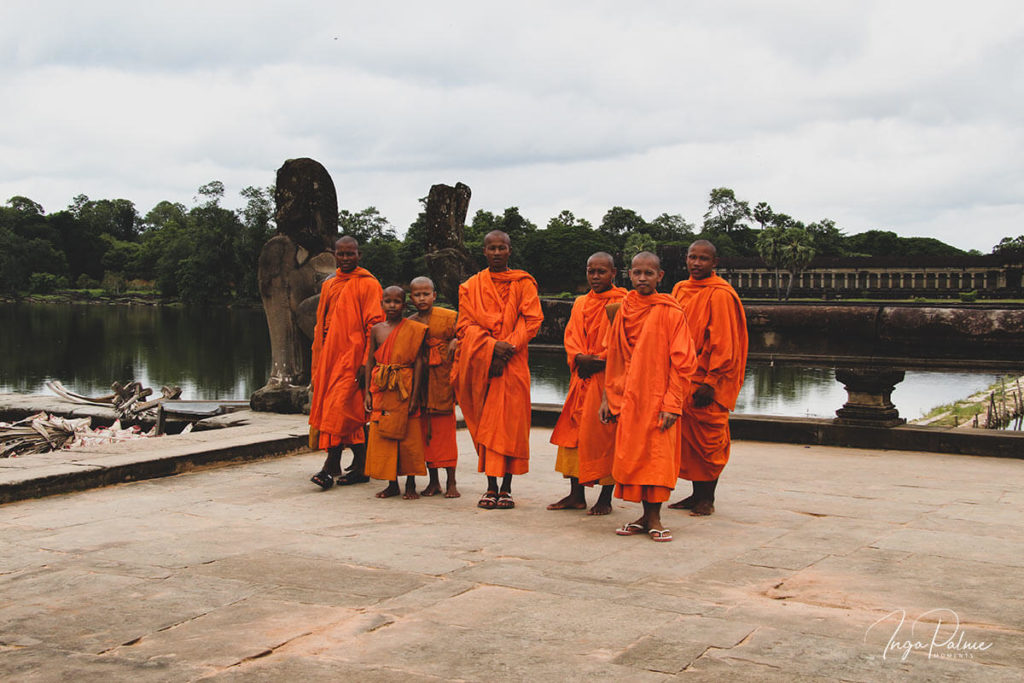
Panorama
At the top of the third terrace you have a great view in all 4 directions. The best view is towards the west. Here you can see the entire promenade that you walked along before. On the horizon is the balloon. There you can see Angkor Wat from a distance and from above. It costs 25 USD to climb up for about 10 minutes. Not so cheap, but it’s worth it.
Statues and Sculptures
On the outer wall of Angkor Wat is the sandstone statue of an eight-armed Vishnu figure. Vishnu is the most important deity in Hinduism. Originally, the figure inhabited the main tower of Angkor Wat, but according to tradition, monks moved it to its current location in the 16th century. Both Buddhist Khmer and Hindu visitors revere the statue to the highest degree.
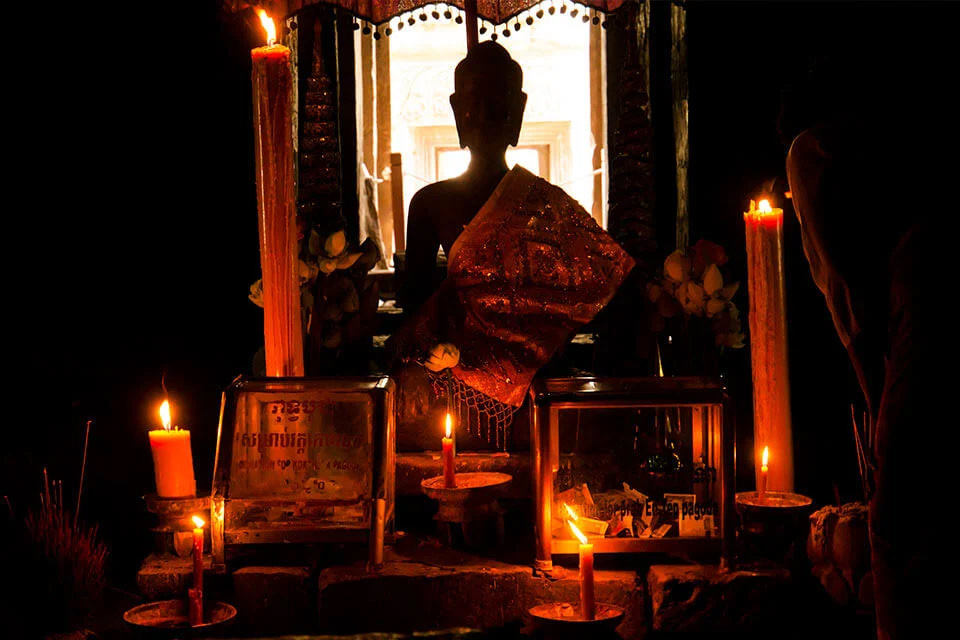
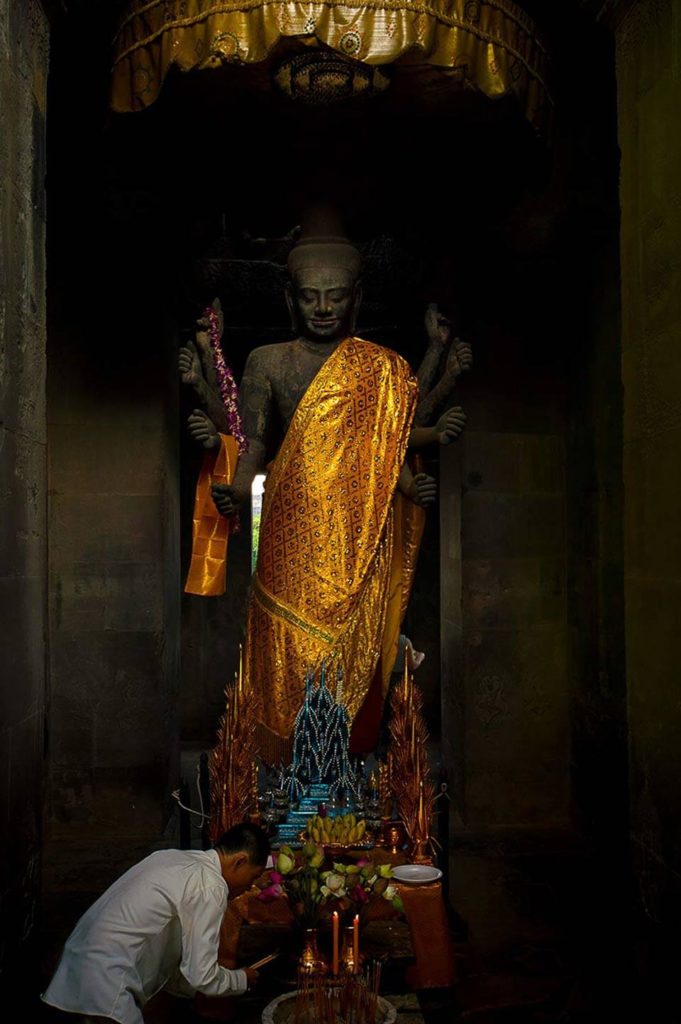
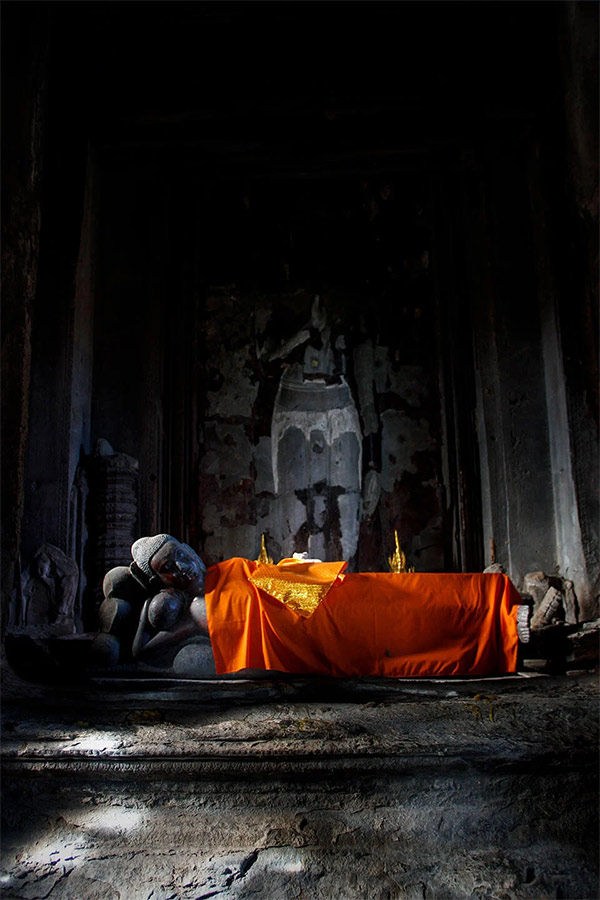
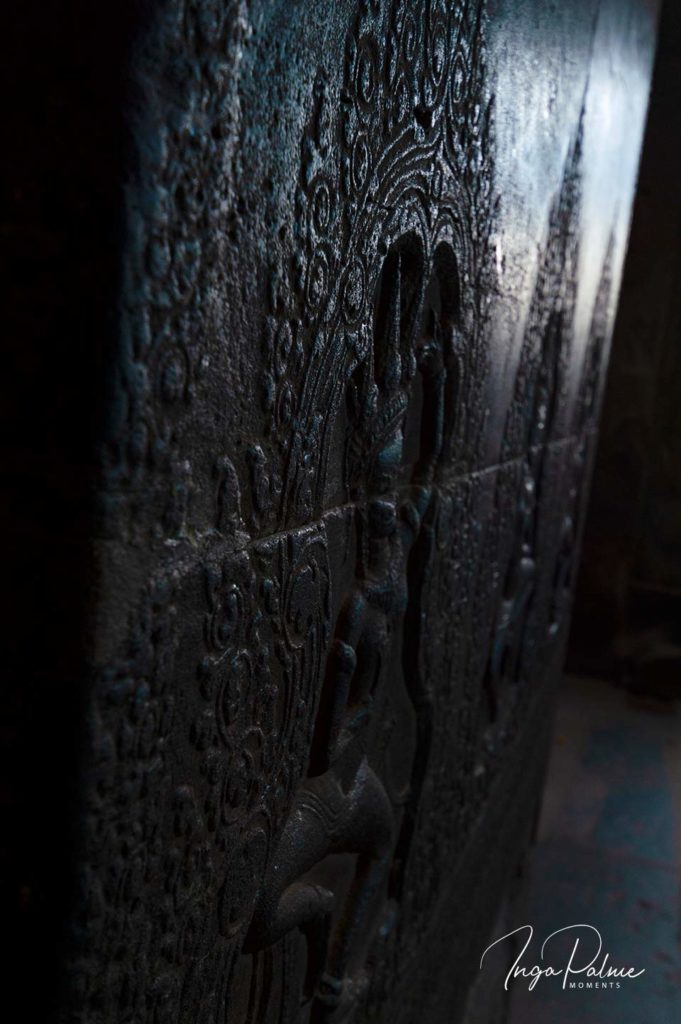
In the course of the religious orientation towards Buddhism, the head of the formerly Hindu statue has been replaced by a Buddhist one. Since then, the spirit of Ta Reach has lived in the statue – an ancestor spirit of the highest order. In the book “Invitation to Angkor” by Reinhart Zieger you can read that Ta Reach is even the spiritual house spirit of the whole of Angkor Wat.
You will find more statues at the top of the middle tower of Angkor Wat and in the galleries of the cross on the first terrace. Your tour guide will be happy to show you the relevant places.
Suitable clothing and equipment for visiting the temple complex
Even if it is hot in Cambodia and you would prefer to visit Angkor Wat as lightly dressed as possible, it is a sacred temple. Tourists are therefore advised to dress respectfully.
This means that you have to cover your shoulders and knees. Bare upper bodies are taboo. Make sure that your clothes are appropriate. Otherwise you may be denied entry to Angkor Park. Since it was suddenly “in” among some visitors to take nude photos in Angkor Park, the Cambodian government issued a Code of Conduct in 2016 with 7 rules of behaviour in Angkor Park.
Angkor Wat & the Chinese
They are not really popular among Western tourists, the Chinese. They come in droves, are loud and sometimes rowdy on their way between the Angkor temples and other visitors. On the other hand, they are the largest group of tourists in Cambodia.
Literatur über Angkor Wat in Kambodscha
Hier eine kleine Auswahl an Büchern über Angkor Wat:
- Angkor: Eine Hommage an die Götter in Stein, Bildband in schwarz weiß mit Fotos von Jaroslav Poncar und Texten von Wibke Lobo
320 Seiten, Edition Panorama 2013, ISBN 978-3898234597 49,80 € at Amazon* - Angkor Wat. A transcultural history of heritage
by Michael Falser, 1200 Pages, ISBN 978-3110335729, 122,99 € at Amazon*
Q&A about Angkor Wat
popular pages about Angkor
Other famous temples in Angkor Park
Very few people spend a whole day at one temple. My record is 17 (!) Angkor temples in one day, because I wanted to have photos of as many temples as possible. Well … :-)
Angkor Thom
The former royal capital of Angkor. An 8-metre-high wall made of laterite and a moat, which also symbolises the primeval ocean. surrounds the whole area. Inside Angkor Thom several temples. Right in the centre is the famous Bayon, which, like Angkor Wat, symbolises Meru, the mountain of the gods. A total of five gates lead into the city, with the South Gate being the most famous. All the gates have faces carved in stone. The two higher ones look in and out of the city. The two lower ones look to the side.
Bayon
The Bayon is one of the most impressive structures of Angkor. The huge faces radiate peace and tranquillity. But you don’t know exactly whether they are smiling or not. The earlier you visit the Bayon in the morning, the fewer other visitors you will meet. I have even been there in the middle of the night and photographed the starry sky with the silhouette of the Bayon.
Ta Prohm
Famous for the Hollywood blockbuster “Tomb Raider”, Ta Prohm has become an absolute favourite with the public. Especially the stone walls overgrown by the roots of the Tetrameles nudiflora are absolute eye-catchers.
All that remains is for us to wish you a breathtakingly beautiful time on your visit to Angkor Wat!

Affiliate*
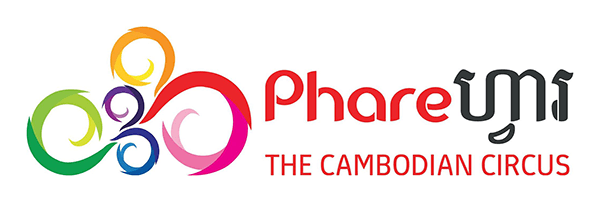
Phare, the Cambodian Circus
A highlight in Siem Reap! Buy tickets online directly on the Circus Phare website*.
Links and references with a * are an affiliate link (advertising link). If you like Visit Angkor and buy, book or subscribe to something via an affiliate link, the provider will make a small commission for Visit Angkor. Of course, there are no additional costs for you.
Join our Facebook group
International travel group with friendly people who love Cambodia. We speak English, German and a little Khmer.
By the way: We write here at Visit Angkor with a lot of passion and love. Nevertheless, it can happen that information is no longer up to date or perhaps even incorrect. We would be happy to hear from you so that we can update the information accordingly. Thank you very much!

